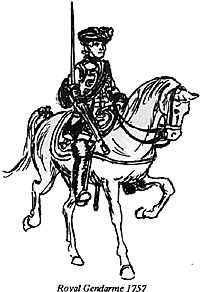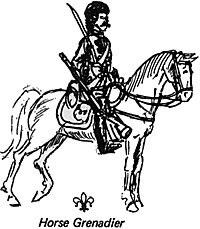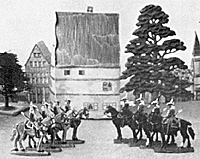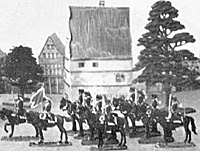 The use of the term "mounted troops" stems from the author's desire to avoid charges of idiocy arising from use of the more common, if less exact, term 11 cavalry." Recalling a recent complaint about Dave's article on American Revolutionary Cavalry, I must assume that many readers are aware that Dragoons are not cavalry. In point of fact, recalling the old expression "Horse, foot, and dragoons," there seems to have been an implied distinction between horse and dragoons.
The use of the term "mounted troops" stems from the author's desire to avoid charges of idiocy arising from use of the more common, if less exact, term 11 cavalry." Recalling a recent complaint about Dave's article on American Revolutionary Cavalry, I must assume that many readers are aware that Dragoons are not cavalry. In point of fact, recalling the old expression "Horse, foot, and dragoons," there seems to have been an implied distinction between horse and dragoons.
Royal Gendarme 1757: Red coat, black facings, yellow vest, gold bordering and cipher on saddlecloth and pistol holsters. Gold trim on jacket and vest.
However, to set the record straight, 18th Century dragoons were not purely mounted infantry. French dragoons fought both mounted and on foot during the War of the Spanish Succession, and in the early part of the century seem to have been regarded as a combination of line infantry and light cavalry. De Saxe, writing about the middle of the century, recommended that dragoons be substituted for hussars, since the dragoon could skirmish mounted and on foot as well as the hussar, but could also charge by formed squadrons - implying that the hussar lacked this capacity. The Anspach- Bayreuth Dragoons (later the 2nd Cuirassiers) of Fredrick the Great's Army pulled off one of the great mounted charges of all times against the Austrians. Although I am not speaking from recent reading on this, I believe that Fortescue (History of the British Army) claimed the re-designation of British Cavalry to dragoons was an economy measure aimed at cutting the allowed maximum payment for horses. However, in spite of this, the British cavalry seems to have been better mounted, on the average, than anyone else's.
 The group shown at right is my own wargame representative of this celebrated regiment, being (even at 25 to 1) a rather weak representative of the 3rd French Company. Critical readers will note that the lace which should be silver on all figures was white, and the standard should have been yellow for this company. (all has been since set right-drat research anyhow.) Bretegnier Figurines painted by the author.)
The group shown at right is my own wargame representative of this celebrated regiment, being (even at 25 to 1) a rather weak representative of the 3rd French Company. Critical readers will note that the lace which should be silver on all figures was white, and the standard should have been yellow for this company. (all has been since set right-drat research anyhow.) Bretegnier Figurines painted by the author.)
Admittedly the dragoons in the French service carried musket and bayonet, but they also carried broadsword and pistols. By 1750 no body of dragoons in Europe, provided they had horses, were as likely to fight on foot as on horseback.
But, as usual, I digress. For purposes of this series, I will be considering the following categories of French mounted troops:
 Cavalry of the Guard
Cavalry of the Guard
These included the Gendarmes du Roi, who wore red coats, and the Gard du Corps in blue, Horse Grenadiers (Grenadier a Cheval) in blue (light blue) and Chevaulegers de la Garde in similar uniform to the Gendarmes, and, of course, the Musketeers (Mousquetaires du Roi), still formed in two companies (originally King's and Cardinal's) on Black and Gray horses. The uniforms of the Mousquetaires; du Roi cannot be summaried even in passing.
Cavalry of the Line:
Units designated as cavalry per se were heavy cavalry, armed with pistols, swords, and carbines, all of which were expected to be used only on horseback. The cavalry came in all colors and varied enormously in quantity from unit to unit, as would be expected. The Royal Allemand and some elite companies of other regiments wore the bearskin, and the Cuirassiers du Roi, as the name implies, were equipped with breastplates. Officers of some other units sometimes appear to have breastplates, at least in old pictures, but whether this bit of RH IP had official sanction or not I don't know.
Dragoons:
I was planning to lump these in with other light mounted troops. However, as they seem to be controversial, and since De Saxe distinguishes them from hussars (which may or may not be a collective term to include arquebusiers, chasseurs, and other miscellaneous types) they will be taken up separately. Dragoons were to be found both in distinct regiments and in mounted companies of "Legions," the latter being mixed commands of light troops which served much the same role as the Austrian vanguard division of Napoleonic times. As stated earlier, the dragoon was typically armed with sword, pistol or pistols, and musket with bayonet. He was expected to fight mounted or on foot, usually mounted, except when budget cuts left him without a horse, which sometimes happened. M. Baldet, in a special series on the dragoons in the SCFH Bulletin (18/3) mentions that some regiments were converted into mixed legions with 3 mounted and 5-8 foot companies.
Hussars and other Light Mounted Troops:
Hussars were first added to the French Army in 1692 as a regiment of Croats, Poles and Turks bearing the title "Hussards Royal." As time wore on more and more regiments of "volunteer" hussars cropped up. According to Knoetel, all of the regiments (Berchency, Turpin, Polleretsky, Linden, Beausobre, Raugrave, and Ferrari) wore light blue Dolman, Pelisse, and pants with white lace and buttons. Earlier, in 1745, numerous volunteer hussars with different uniforms. The commonest headgear at mid-century seems to have been the winged conical shako, though some hussars appear to have worn the bearskin.
Besides the hussars, there were various light mounted companies in the various legions of light troops, including the mounted Arquebusiers de Grassin companies, who looked like hussars with a buff leather short cape in lieu of Dolman - but were identical to the foot arquebusiers except for the feathers on the shakos. Another famous light horse unit was the Freikorps Fischer mounted contingent, which wore a green dolman, red Pelisse, trimmed green, red trousers, yellow metal buttons and lace. Knoetel shows them with winged shako, but others show them with bearskin. For some reason, the troopers of the Freikorps Fischer were chasserrs a cheval, not hussars. Towards the end of the century, or rather, shortly prior to the French Revolution, six line chasseur a cheval units had been formed out of the mounted chasseurs and what have you of the various light organizations, which had, at an interim stage been divided out as fifth squadrons to the line dragoon units (as the latter were becoming recognized as heavy cavalry.)
Hussars, chasseurs, arquebusiers, etc., were, according to De Saxe's critique, not trained to charge by formed squadron, and hence probably functioned best in raids, skirmishes, and dashes against hostile light troops, especially skirmishing light infantry.
De Saxe also raised his own brand of light cavalry - a regiment of uhlans consisting of 4 squadrons each with a slightly different uniform, or rather, a uniform of similar cut but different coloring. The overall costume was Polish, like most of the troopers. The headgear was a tufted helmet banded by a turban-something like the helmet adopted by the dragoons between 1760 and 1780, and a distant relative of the familiar heavy cavalry pattern worn by dragoons and cuirassiers (in different colors) during Napoleon's heyday.
The Uhlans de Saxe are offered by a number of flat manufacturers, even though the regiment did not much survive it's founder's death, being raised in 1734 and disbanded in 1750.
GUARD CAVALRY
So as not to waste this issue entirely, let's get down to cases for the first category on our list.
Gard du Corps
This was the senior regiment of household cavalry, raised 1st Company in 1440, 2nd and 3rd in 1474 and 1475, and the 4th in 1514. Each company at times consisted of a captain, 3 lieutenants, 3 ensigns, 1 drummer, 6 trumpets, 24 non-commissioned officers, 6 standard bearers, and 360 troopers. The six standard bearers were required because each company was divided into 6 brigades, three commanded by lieutenants and 3 by ensigns, each with its own standard.
In 1757, as around the turn of the century, the regimental uniform was blue with red trousers, coat lining (showing red when turned back - which was more customary at mid-century and later) and cuffs. The coat sported a great deal of silver lace, with two broad bands of silver on the red cuffs and red vest. The tricornered hat was also trimmed in silver. Bandoliers and equipment straps were silver with checks or squares of the company color along the middle.
The companies were as follows:
| Company | Name | Company Color |
|---|---|---|
| 1st | Scottish | White |
| 2nd | 1st French | Green |
| 3rd | 2nd French | Blue |
| 4th | 3rd French | Yellow |
Flags and saddle cloth were in the company color, with the exception that the saddle cloths of the Scottish company were red. Flags in company color had fringes of gold alternating with silver, scroll work inside the border, and a gold sunburst at the center. Similar trim applied to the drum and trumpet banners which had crowns over red circles outlined in gold laurel leaves in the center, the crown being gold.
Musicians wore coats striped with silver. However, even Chef d'Esquadron Lyot is not clear whether the trumpeter he shows in SCFH 38 No. 3 wears blue as a company color or if all companies wore blue as a basic color to that silver colored coat. My guess would be the latter, but of course that isn't worth much and Knoetel is rather silent on the matter. The cockade for this regiment is blue for the regiment.
The Garde du Corps had an excellent reputation most of the time, and turned back the British household cavalry two or three times at Dettingen, before being carried away in the rout. However, like most of the French cavalry, they may have been slow to adopt the full charge as a cavalry tactic, being adept at manuevers, nonetheless, and extremely skillful with all their weapons.
Mousquetaires du Roi
Going back to the 17th Century, when the duels between King's and Cardinal's companies occurred which have become so famous in Dumas, there were apparently two companies in this organization. Both wore red coats covered with blue cassocks, and red saddle cloths.
The first company rode gray horses, had a white pectoral cross on the cassock, with red flames around it, and had rich gold embroidery on the edge of cassock and saddle cloth.
The second company, on black horses, had silver instead of gold and a yellow flame around the cross.
 Shown here are the black and gray companies facing one another. Are they about to carry on the old tradition? Note that the musketeers carry their muskets in the dragoon fashion and wear the bayonet scabbard above the sword. (Bretegnier figures painted by the author.)
Shown here are the black and gray companies facing one another. Are they about to carry on the old tradition? Note that the musketeers carry their muskets in the dragoon fashion and wear the bayonet scabbard above the sword. (Bretegnier figures painted by the author.)
Plumes on the hat lining and cockade were white.
Musketeers, naturally enough, carried muskets, as well as two horse-pistols, broadsword, and bayonet.
I can in no way vouch for the size of the companies, so I use a base of each.
The Gendarmes du Roi
This regiment wore a red coat with black facings and yellow vest. Knoetel gives the color of the trim, which, except for the style on the cuffs, was similar to that of the Gard du Corps, as gold. This follows my notes from color prints for around 1740-57, but Dr. MacCarthy in No. 6 of the Sabertache/SCFH publication indicates that in the 1770's the facings were yellow, trim silver, and the large cuffs of the earlier period had disappeared.
I mention the changes by way of warning, since the bandolier pattern followed company colors in a strip on gold, and the only company colors I have are from Dr. MacCarthy's article dealing with a later period.
The same article shows a black front piece of a cuirass peeking from under the coat of a Gendarme.
Organization in 1772 consisted of 10 companies each of 30 men about 18 of whom were officers. This may be a very reduced cadre, although having officers in the ranks was common to the Gendarmes and Gard du Corps. Company colors (bandolier and perhaps guidon) were:
- 1 Scottish-Yellow
2 English-Violet
3 Burgundy-Dark Green
4 Flanders-Dead leaf
5 Queen's-Red
6 Prince's Sky Blue
7 de Berry - Royal Blue
8 de Provence - Light Green
9 d'Artois-Crimson
10 d'Orleans-Aurore (I. orange)
This regiment was also involved at Dettingen and Fortenoy. At the first mentioned battle George :1 knighted a young trooper who recaptured his regiment's standard from a Gendarme and cut his way back out - with a somewhat chewed up standard but short an ear and some fingers.
For the late period, MacCarthy suggests that the trumpeters wore a blue coat trimmed all over in silver, which would probably have been gold earlier. Tolman shows an indistinct Gendarmes de Burgundy in red striped white with goldbuttons on the red and blue trim on either side of the white bands.
 Early 18th Century French Dragoons halted. These troopers are wearing the stocking cap with fur base which disappeared largely from field wear by mid-century The same pattern was still issued as a fatigue or garrison cap however. Dragoons carried the swallow tailed guidon as illustrated here rather than the small square standards of cavalry. (Bretegnier Figures, guidon painted by M. Pierre Foure.).
Early 18th Century French Dragoons halted. These troopers are wearing the stocking cap with fur base which disappeared largely from field wear by mid-century The same pattern was still issued as a fatigue or garrison cap however. Dragoons carried the swallow tailed guidon as illustrated here rather than the small square standards of cavalry. (Bretegnier Figures, guidon painted by M. Pierre Foure.).
The cockade is black for the Gendarmes, and Knoetel states that an additional regiment, the Chevaulegers de la Gard, had the same uniform with a white cockade, but I have no other information on that regiment.
Grenadiers a Cheval du Roi
Here again, I have nothing to go on but Knoetel. He gives a light blue coat with trim in white similar to the trim on the senior guard cavalry units. The cuffs, vest, and trousers are red, as is the cap, which is surrounded by a black fur band. The horse grenadier shown by Knoetel, as those cast by Bretegnier for around 1710, carries his musket in dragoon fashion as opposed to a carbine slung muzzle down.
More French Army in the Mid-18th Century
- Part 1: Infantry and Flags (1)
Part 2: French Infantry Regiments of the 7 Years War Uniform Chart
Part 3: Artillery
Part 4: Cavalry (1)
Part 5: Cavalry (2)
Part 6: Infantry
Back to The Armchair General Vol. 3 No. 3 Table of Contents
Back to The Armchair General List of Issues
Back to MagWeb Master Magazine List
© Copyright 1970 by Pat Condray
This article appears in MagWeb (Magazine Web) on the Internet World Wide Web. Other military history articles and gaming articles are available at http://www.magweb.com
